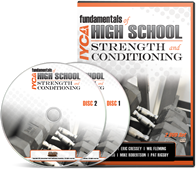
Every year, I’m both honored and humbled to be asked to present at the annual Perform Better Summits.
As goofy as this may sound, I remember vividly being a young Strength Coach and receiving copies of the ‘Perform Better’ catalog in the mail… And having absolutely no money to purchase any of the books, DVD’s or other educational resources that PB has been putting out for years!
But what I recall most about those lean years was my hunger to succeed and ambition to become just like some of the people displayed in the pictures within those PB catalogs. Industry greats – Mike Boyle, Vern Gambetta and Juan Carlos Santana – to name just a few.
This will be my 4th year on the Perform Better circuit, but every year feels like the first. To be thought of in the same breath as the legends I just mentioned and considered worthy enough to be part of the breathtaking line-up of talented speakers Perform Better hosts every year… It becomes more and more humbling every time I think about it.
This week, I decided to write about my topic for this year’s Perform Better seminar:
Long-Term Sports Training Development Models
If I won’t see you in either Chicago or Long Beach, then this week will give you great insight into my planned topic and discussion points for the conferences.
If you’re planning to be in either of those two locations, then this week will be a great prelude to my talks.
Point #1 – It All Works… But What Works Most Optimally?
As I’ve being staying for years, simply addressing biomotor improvements through basic, ‘value-based’ assessments is about the biggest disservice we could possibly do for our profession and the young athletes within our care.
(A) Young athletes become conditioned to the culture of ‘value-based improvements’, which can be a terribly detrimental factor when considering the notion of them (and their parents) buying in to the realities of a long-term athletic development model.
(B) Fixation on ‘the numbers’ allows for easy transition into the world of false positives. Benches, Squats and Clean numbers can go up without so much as one iota of concern regarding proper form and function through lift mechanics and summation of forces. In reality and especially with young people, you can get stronger and become functionally weaker at the exact same time – think about that concept and let it burn into your brain.
(C) Inappropriate perspective implies that while you, your young athletes and their parents are overjoyed with the statistical improvements being showcased, the broader reality is that within this age group (10 – 18), we see the natural occurrence of the largest influx of testosterone and other human growth related factors throughout the continuum of our entire lives. In short, improvements are BOUND to happen within this age range – it’s not necessarily what ‘You’ did to make your young athletes faster and stronger, but more of what ‘Nature’ was already in the process of doing.
(D) Training age plays a significant role in the development of biomotor abilities. It is no secret that the younger your training age, the greater the percentage of gains can be made. Young athletes have incredibly low training ages and so, again, are absolutely bound to show improvements completely and entirely devoid of what you may or may not be doing in terms of programming.
Be sure to come back tomorrow and understand my stance on ‘MOLD’…
In the meantime, to better understand my ‘Long-Term Sport Training Model’ click here:
–> https://iyca.org/highschool/
– Brian


